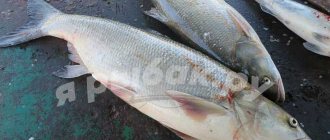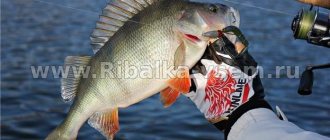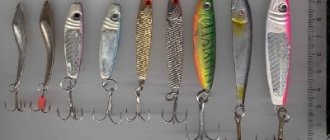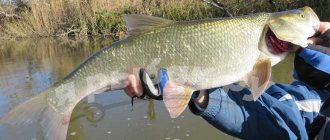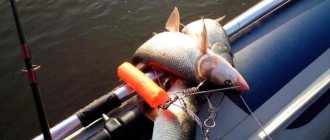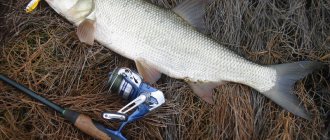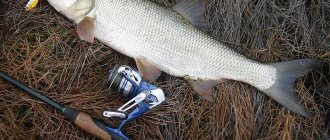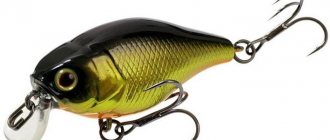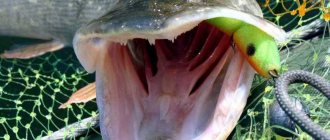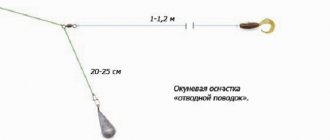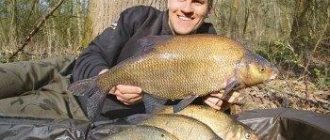Asp habitats. Where to look for asp?
The asp is very popular among fishermen, and they catch it with great interest and excitement.
Mostly the asp prefers to choose lowland rivers with a calm current for living, but it can often be found in lakes, as well as reservoirs that are artificially formed during the construction of hydraulic structures.
In warm seas, this fish leads a semi-anadromous lifestyle. In fresh water it prefers to feed on bleak.
Gear selection
Tackle for catching asp with live bait is selected depending on the time of year:
- In early spring and in the second half of autumn, the predator stays in the near-bottom horizon. That’s why donka is often used for fishing.
- In the middle of spring and autumn, as well as during prolonged cold spells in the summer, the asp hunts in the water column. Match gear with blind rigging comes to the fore, allowing you to present the bait in the desired horizon.
- In summer, the asp feeds near the surface. To catch it, you should use float rigs that allow you to keep the bait in the upper layers.
Recommended reading: Catching carp with a cast
The most universal are float tackle for long-distance casting. They are designed for fishing from the shore, regardless of the horizon of the predator.
Rod
Long-distance casting gear consists of a match fishing rod or spinning rod with a cast of 15 to 40 grams. The range of the kit is achieved due to the length and action of the tool. For an asp, it is better to take a medium or slow “stick” 3–5 meters tall.
Coil
The rod is equipped with a spinning reel, which should perfectly balance with it, without tiring the angler during the fishing process. It is better to take a product from a well-known manufacturer with good line laying, a velvety stroke and a sensitive friction brake.
fishing line
A monofilament line with a thickness of 0.28–0.35 mm with a breaking load of at least 5 kg is wound onto the reel spool. The nylon thread flies far, is invisible in the water and does not alarm a suspicious asp; when biting and retrieving, it confidently dampens the jerks of the weighty predator.
Float
A transparent plastic ball is often used as a float. Its main task is not to signal a bite, but to help the fisherman track the location of the bait so as not to lose sight of it. There are models that are filled with water, making the equipment heavier and increasing the casting range and accuracy.
The asp is a cautious predator, so the stealth of the gear determines the effectiveness of its fishing.
The equipment consists of:
- leash;
- hook;
- lead load.
For the leash, use fluorocarbon or monofilament thread with a smaller diameter than the main line. Its length is 0.7–2 meters, depending on the fishing conditions, the horizon where the sheresper is located, and the fishing distance.
A single leash is tied to the leash, or less often a double. When assembling the equipment, you must ensure that the hook is located at a distance from the float, without arousing suspicion in the asp. When fishing near the surface, the equipment is not weighted; when fishing in the depths and near the bottom, you have to put lead weights on the line to keep the bait in a given horizon.
We recommend reading: Fishing line for carp fishing: selection, use, storage
The best time of year for asp fishing
The most optimal time of year for asp fishing is early June and until autumn.
It is during this period that it is easiest to catch a large specimen, and the chances of catching at least something also become greater.
In principle, you can start trying from the moment the snow melts, but it should be borne in mind that when the water temperature still fluctuates at a low level, the fish hunts at depth, and not at the surface, so it is more difficult to distinguish the feeding areas of the asp, which complicates the process.
In summer, the water warms up, and he begins his hunt for prey in the upper layers, near the surface of the water, so that even the naked eye can see and hear it;
Closer to autumn, when the temperature begins to drop, it goes deeper and deeper again.
When to catch asp
The best time for asp to bite, of course, is the post-spawning feast from the beginning of June until the end of August. The asp bites especially well during this period after sunrise and throughout the daylight hours.
It is worth noting that the asp is caught only during daylight hours; at night it is inactive.
According to some sources, the asp feeds about 3-4 times a day, but according to other sources, the asp does not stop feeding throughout the day, since, unlike pike, it generally does not wait for prey in ambush, but, on the contrary, actively searches for it and hunts for fry, covering considerable distances per day. This lifestyle requires a lot of energy, which makes the opinion that the asp feeds only 3-4 times a day can be called into question. Except that each time it lasts several hours.
Usually, the feeding time of the asp is noticeable from afar. Its violent splashes on the surface of the water cannot go unnoticed by the fisherman. It is in the places of such jumps that you should hit the bait. The asp, carried away by the pursuit of prey, is ready to grab any bait that comes his way. The asp is most active from dawn until about 10 am. It is at this time that they switch to catching asp with a splash. During the day, its bite continues, but not so actively and it is splash fishing that is the only right decision. The evening bite of asp begins at 6 pm and lasts until dark.
Top 6 most popular ways to catch asp
There are several types:
On Spinning;
Fly fishing;
Donkoy;
Using a float rod;
Floating;
Path.
Catching asp with a spinning rod. Tackle, technique and fishing tactics
You need to start first of all with choosing the spinning rod itself - this is one of the main components of success.
The length of the fishing rod must be at least 1.4 m and no more than 2.7 m. The very size of the reservoir in which the event is planned should be taken into account.
However, for beginners it is best to choose a stick at least 2.7 m long, since the specificity of a spinning rod is that the longer it is, the easier it will be for you to cast.
The second very important and basic aspect of fishing is casting accuracy.
To make the task easier, it is recommended to equip the reel with thin mono or braided fishing line.
The rod's rings should be of good quality, and it is preferable to use a spinning reel.
The diameter of the first throughput ring should range from 30 to 35 mm. Experienced fishermen strongly advise against purchasing hard rods or overly fast spinning rods.
The asp resists much more energetically when it gets hooked, so a rigid rod can break under its pressure.
How to catch
This representative of cyprinids can be caught in different ways. But, naturally, as in catching other predators, it is better to catch asp with a spinning rod. This is at the same time a difficult hunt, but very dynamic, exciting and rewarding. Fishing for asp with a spinning rod allows you to catch a variety of predators using different types of bait - from ultralight to classic asp and jig.
Catching asp using a spinning rod can be done using different methods. The predator is successfully caught with classic asp spoons, wobblers, and spinners. Asp are quite good at catching with a beard, with a shaitan breaker, with a retractable leash, with streamers and other specific baits.
Asps are also caught by fly fishing, especially in the summer. This method is most suitable on small rivers, where a large proportion of the predator’s diet consists of grasshoppers or beetles that have fallen into the water. Large flies and streamers are used. On large rivers, donka can also be used, but only in cold water, when the fish feeds at the bottom.
Spring
Catching asp in the spring is possible before spawning in early March or after the predator has spawned, when it begins to eat. In early spring, these fish can be caught on a jig as they are still near the bottom and not rising to the surface. To successfully catch an asp with a jig, you need to know where it is concentrated. However, not all rivers and reservoirs allow asp fishing in early spring.
After spawning in May, when the sheresper begins to actively hunt at the surface, spinning anglers switch to castmasters and other jigs, use driven small-running wobblers, ultralight baits, barbs and others.
In May, the asp switches to a summer feeding regime and begins to eat, so now jig will be relevant only from the second half of October.
Fishing for asp using a spinning rod in the spring is most productive along steep banks. The secret is that the fish patrols the area, making periodic attacks on the fry standing at the very edge. The best baits in this case are a wobbler and a spinner.
Summer
The asp spends the entire summer period in the surface layer. It feeds exclusively during the daytime and is not caught at night. His favorite stopping and hunting places are:
- shallow waters;
- braids;
- shallows;
- riffles;
- steep banks;
- under overhanging trees.
What to use to catch asp in the summer depends on the chosen fishing method. Classic spinning asp fishing is done with a castmaster at a long distance. Other catchy, narrow-bodied, heavy, oscillating spoons, called jigs, are also used. The fishing technique comes down to long-distance casting to the predator's fighting areas. Catching asp in the summer with a beard can be effective, where homemade flies or streamers are often used as bait. Lures such as shaitan burun, spinnerbaits and poppers are also used.
Fly fishing for asp is effective in the summer. All kinds of flies and streamers are used to imitate semi-aquatic insects. On some reservoirs, especially small rivers, asp are better caught in summer by fly fishing than by spinning. The best fishing technique in this case is to cast under overhanging tree branches and float the fly with small twitches.
Autumn
At the beginning of the autumn season, while the water is still warm enough, the asp remains in the surface layer and continues to actively feed on small fish. This period usually lasts until the end of September. In October, the sheresper gradually begins to move to deep areas, only occasionally showing activity at the surface.
As the weather gets colder, jig becomes the main method of catching autumn asp. The fishing technique is the same as for pike perch. Small, runaway silicone baits are used - twisters and vibrotails. It is better to use a hinged installation, and in catchy places you need to use an offset hook.
Jigs also continue to work, only now it is better to carry them out at the bottom or in the water column using a wave-like or stepped retrieve. Front-loaded turntables can be used. Beards, streamers and other similar methods cease to give stable results in the fall. Very rarely an asp is caught on the track. In this case, the predator bites on small stubborn cranks held near the bottom.
Advantages of spinning reels. 3 main advantages
Easy and smooth glide;
Many models have a system that ensures casting range (ABS or Long Cast);
The gear ratio should be in the range of 5.1/1, and the spool diameter should be from 3000–3500.
Based on the experience of many professional and experienced fishermen, we can conclude that thick wattle nets in asp fishing are not sufficiently effective, so it is recommended to change the large diameter to a smaller one - in the range from 0.14 mm to 0.16 mm.
Such parameters will be enough to fight this wayward fish and will not frighten you with its size.
6 asps in 7 minutes per castmaster (video)
Fishing for asp in winter in open water
This large carp fish is also caught in winter. Moreover, the silver beauty is caught both in open water on non-freezing reservoirs and from ice. As soon as the winter cold sets in, the asp fights known to all fishermen end. This predator descends closer to the bottom, as these are its new places for hunting in winter.
In winter, asps are successfully caught on city canals and reservoirs not covered with ice. Such reservoirs usually have many tributaries in the form of springs and springs. The water there is warmer than in frozen reservoirs. Therefore, there is a lot of oxygen needed for fish. This makes the asp active, although he is no longer as violent as he was in the spring and summer.
In winter, people fish for asp in open water using a spinning rod. But there are many nuances to such fishing. Firstly, you need to dress warmly. Secondly, the reel often jams and the line freezes. And thirdly, it is more difficult to find an asp in winter, since there are no visible fights of this predator.
The fish does not slap its tail on the surface of the water and therefore you have to look for it blindly. But if you wander with a spinning rod in your hand through those parts of the reservoir where there are a lot of small fish, then fishing can be successful. In order not to frighten the aquatic inhabitants, you need to dress in camouflage-colored fishing clothes or just a dark-colored suit.
In winter, finding and catching an asp is very rare.
But a bright jacket will scare the already suspicious winter fish. The juvenile fish will be frightened, and after them the large representatives of the ichthyofauna. Experienced fishermen should wear white clothes to match the color of the snow. Such costumes are usually worn by snowshoe hare hunters in a snowy forest.
From a boat you can successfully catch asp using wobblers or jig baits, which are sold in a large selection in our fishing stores. Wiring is carried out at random at the edge of deep holes and near the bottom.
You can use artificial baits such as twisters, which in Central Russia in December sometimes catch asps weighing ten kilograms in open water. For such fishing, it is better to use not a braided line, but a monofilament thread, which is not so visible to the asp.
Typically, a fishing line with a thickness of 0.27-0.30 millimeters is chosen. If in these places, in addition to asp, large pike also live, then you can put a metal leash. After all, pike teeth, unlike asp teeth, are very sharp and can bite through the thickest monofilament line.
Sheer fishing with a spinning rod also gives good results. They use spinners that resemble topwater fish or spinner spoons. When flashing like this, you need to alternate jerks with five-second pauses.
Fly fishing for asp
How to fly fish?
For such fishing, a 8-class rod is usually enough, but a 9-class rod is also possible. If the asp’s bite is in the active stage, then it is caught using a floating line and streamers or dry flies.
If hunting takes place at half-water level, then the line should be sinking and the bait of the appropriate class.
The most effective place to use fly fishing is in the shallows. When catching asp in this way, they usually use:
Various flies, grasshoppers and streamers of different colors;
The cockchafer is also well suited for such purposes;
Of the artificial flies, it would be optimal to use dry flies in a light color scheme.
In order to catch an asp in this way, it is important to choose the right equipment:
The cord must be floating or intermediate, and the undergrowth must be 2 to 4 m long;
Unlike spinning fishing, the fishing line should be thicker so that when the fish grabs the bait, it does not break.
Once the gear is selected, you can start fishing. To do this, having chosen a convenient place, you should throw the wire with flies across the current and hold them lightly. During the process, you can tighten the cord at different paces.
When fishing occurs in river flow conditions, it is necessary to pull the bait towards you, and if it occurs in standing water, then the pull should be carried out slowly.
Fly fishing for asp on the Dubossary reservoir (video)
Tackle
Classic asp fishing involves the use of high-quality and powerful gear that allows long casts of heavy spoons. A spinning rod for asp fishing must have a sufficient margin of safety and be long-range. The fishing line should preferably be monofilament, which also affects the casting distance. Naturally, the fisherman must also master the long-casting technique.
When fishing for asp with jig, you can use the same gear as in coastal fishing for pike perch. There are no special requirements for ultralight, although for asp it is better to use a braided cord, since it is more durable than thin monofilament.
Asp baits. Top 5 best baits
There are several types of bait that are most effective for catching this type of fish.
Devon is the most complex bait, which is very difficult to make on your own and difficult to find in a store in terms of price and quality.
When choosing this bait, you need to consider several points:
It should rotate easily;
Good weight in relation to compactness;
It is best to take a bait of this type made of lead;
High rotation speed. It should be noted that for solid Devons it is lower than for combined ones, the blades of which are made of brass or copper.
It is best to fish using the simultaneous use of baits, 2 types - left rotation and right rotation.
Trihedron - the purpose of this device is fishing in the water column at almost any depth. This is especially true in the spring and autumn.
Due to the fact that the trihedron seems to fall into the water, it is most popular among fishermen because of its efficiency. Most often, hunting with this bait can be found in the Middle Volga, where pike perch are also caught with it.
Castmaster is rightfully called a universal type spinner. With its help, asp can be caught in different ways.
For example, in the summer, when fishing mainly takes place in the upper layer of water, they use castmaster lures at high speed, and with the arrival of cold weather, they throw them to the depths and pull them up with steps.
If fishing takes place from a cliff, then with the help of this bait the spoon is pulled to the surface using a stepwise method, but at a careful and slow pace.
Jig - used for fishing in cold water. The use of this bait is used in a step-type method.
First of all, it should be taken into account that in the autumn and spring the asp usually feeds near the bottom and especially likes riffles, and it is in such cases that jigs are most effective. On such fishing you can catch a fairly large individual of this type of fish.
Wobbler - provides maximum opportunities with minimal restrictions.
For example, this bait is effective even if the asp does not show itself in any way on the surface of the water. Then you need to stand with the current and throw the gear across the current and slowly pull it up. This method is very effective.
Or another method. You should choose a place on the edge with a shallow depth - about 30 m from the spit and cast. A very effective bait and justifies itself in catching asp.
Catching asp with a spinning rod. Lures used: spinners, spinners and wobblers.
Catching a “river corsair” with a spinning rod is a classic and indispensable summer fishing method. The “lifestyle” of the summer asp is constant patrolling of its hunting territory with occasional trips to the surface, accompanied by tail strikes. Basically, the “river horse” hunts in the upper layer of water, its mouth is small, and accordingly it takes medium-sized prey - tops and bleaks.
His hunting method is stealth, that is, the “river corsair” chases prey “in full sail”, and does not attack from ambush. This is, perhaps, one of the main difficulties of fishing; in order to find our “pirate”, we must attack his hunting path. It should be noted that the predator has extremely sharp eyesight; upon noticing the fisherman, he ceases to be interested in the offered baits.
You can catch the watchful, careful sheresper only by long-distance casting to the places where our “river pirate” cruises. The motto of the spinning rod fisherman is like that of fighter pilots: height, speed, maneuver! Accordingly, two-handed sending spinning rods with a high-speed reel with a wide Long cast spool are used for ultra-long casting. It is preferable to use not “braid”, but monofilament no thicker than 0.25 mm, which is less noticeable in the water, and its stretchability makes it easier to fish out a stubborn predator.
The “splash” fishing tactic could be something like this. Having noticed the “fight” of an asp from a distance, you must immediately, without hesitation, give him bait. You need to place your bait not exactly in the place of the fight, but in the direction of the fish, anticipating its movement. It is clear that this fishing requires utmost attention and masterful use of gear. The spinning player must show a quick reaction and be able to cast long and accurately.
What spinning baits are best to use? The requirements for baits are: range and similarity to a food object. We focus on the food preferences of our hero – verkhovka and bleak. That is, the bait should be small, narrow and silver. They say that there are one hundred varieties of asp baits. Maybe this is an exaggeration, but there really are a lot of baits.
Firstly, rotating spoons (spinners). Small spoons with a narrow petal (like Aglia long) and silver color are suitable. It’s even better if the spinner is long-range, with an axle weight (the French company MEPPS Aglia long, the Swedish company MYRAN Agat, Tony-Z, and the company BLUE FOX have such spoons). The spinner with a body in the shape of a silver fish, DAIWA Silver creek, is very good. The asp does not favor front-loaded spoons with a sinker in the shape of a fish head.
Further. Spinners. The first and most honorable place rightfully goes to Kastmaster from Acme Tackle (USA). Who doesn’t know this lure in the form of an oblique cut of a cylinder! This spoon was invented in the States and was initially used for catching American bass, but our asp also “liked it”, so much so that it became the number one bait.
In second place we can put a Russian invention - a triangular spinner. In terms of range and catchability, it can be compared with a castmaster. Just like the castmaster, this lure is quickly cast in the upper layer, but it can also be fished with a “step” in the water column. Many companies have excellent narrow oscillating spoons of various designs that can be successfully used when catching asp. These are such spinners as MEPPS Syclops, More Silda (by Blue Fox), Tony by ABU GARCIA.
It is impossible not to mention such an interesting and catchy bait as the Devon. Devon is like a mini-turbine with two propellers rotating in antiphase (so as not to twist the line). Passing in the upper surface layer, the Devonian creates turbulent eddies around itself that attract asp from a great distance. It’s a pity that high-quality Devons with bearings are very expensive, and low-quality ones are not worth buying.
Let's especially say about wobblers used in asp fishing. In general, any models are suitable - floating, sinking and suspenders - that have an elongated “minnow” geometry, silver color and do not exceed 7-8 cm in length. But, of course, the best wobblers will be those that are designed for long-distance casting .
For example, you can note the Aile Magnet YO-ZURI wobbler with a magnetic loading system, which allows you to make long-distance and accurate casting. Another wobbler that has proven itself when catching asp is the Rip-n-minnow 65 OWNER CULTIVA. Almost every company has wobblers that fly far and accurately and have a suitable geometry. This could be Rigge JACKKAL, dr Minnow DAIWA, Long Cast RAPALA, Count Down RAPALA. Surface bladeless wobblers are also used when fishing for asp - walkers such as MEGABASS X55F, OWNER CULTIVA Zip-n-Ziggy.
Different wobblers require different approaches when fishing. Sinking heavy wobblers with a long-distance casting system can be thrown, just like spinners, into the asp “fighting” areas. Suspender wobblers can be deployed by releasing them behind the boat for a considerable distance, including crossing the place of the “fight”. And finally, floating wobblers can be floated downstream from a boat or from the ends of capes and islands.
A few words about the tactics of fishing with wobblers. It would seem simpler - throw and pull! But it was not there! As a rule, the “river corsair” does not respond to a primitive presentation of bait. You can only catch fish that the fisherman cannot see. The “mountain” asp is extremely cautious, distrustful, and timid; if it notices a fisherman, it stops responding to bait, and it is not always possible to throw a wobbler to the place of its “fight.” We have to resort to tricks.
If the asp does not allow the asp to come within sight of a targeted cast, then they resort to the “track” fishing technique. A floating wobbler or suspender is released over a large length of fishing line (50-80 m) and ply the boat without approaching the place of “fight” or pulling the wobbler through the expected exit points of the predator. Even in the heat of the hunt, the “river corsair” does not lose vigilance: if the boat comes closer than 50 meters, the “fight” moves further. With this method of hunting, you can count on a wandering asp who walks wherever he pleases.
On rapids and rapids they act differently. The boat is anchored 50 m above the riffle, the wobbler is floated downstream to the riffle hole, then slowly, with stops, it is pulled up. Those fishermen who find it tedious to float the bait downstream for a long time can pick up a second spinning rod and, during the rafting, make radial casts on a jig or spoon.
The area of the overflow hole and the dump into it is fished especially carefully - it is from there that the asp makes its throws upstream. The wobbler does not have to be floating and shallow; often success is brought by a wobbler going shallow under the surface (Shallow runner). Bites are possible when the wobbler stops, when the bait is simply playing in the current.
The described technique for catching bait with alloys is also applicable when fishing from the shore. Only for this you need to choose places where the current can carry the bait far from the shore - elongated capes, ends of islands, bridges. The floating wobbler is released with the current, but they do not just let the line reel in with the handle folded back, but slightly slow down the bait, passing the line between the fingers. A bite can happen during rafting. When the asp is picky about the type, size, and color of the bait, the wobbler needs to be changed from time to time.
During bad weather, as well as in places with sharp changes in the bottom, a sinking bladeless wobbler of the Rattlin RAPALA type, which is guided by a step in the bottom layer, will help. It’s good if the wind creates small ripples in the water and the fish does not see the spinner. In such conditions, an asp can take even at close range.
In autumn, as the water gets colder, our “river pirate” appears less and less on the surface, more often hiding in the depths. The most popular bait is a small light-colored vibrotail. In cold autumn water, the asp stands at depths, on changes in the bottom and responds well when fishing with a bottom jig step.
In late autumn, the asp continues to feed, but it must be taken into account that it can be found not on the rifts, but on the bottom dumps near the rifts. You can, for example, catch a “white predator” by periodically casting to those places where the sand spit borders on a sharp edge.
If we fish at depth, and even among flooded trees, where our corsair likes to hide, we must be prepared for the irretrievable loss of bait, so an inexpensive vibrotail is preferable to a wobbler or castmaster. Closer to winter, the asp gets into deep holes and catching him is already problematic.
Tips for beginners. A few main rules on how to catch an asp
If a person has never gone fishing for asp, he will need to know at least the basic method of catching this fish.
The traditional method of catching asp is using a spinning rod. To do this, you will need to equip it with propeller-type spinners called “Devon”.
With this kind of gear you need to cast a little further than the spots where the fish splashes.
The asp swallows the spinner the moment it sinks into the top layer of water, so further actions require accuracy and speed.
In some cases, the fish swallows the “Devon” immediately, at a moment when the casting circles have not yet dispersed; at such moments, the asp begins to actively hunt for it and the illusion of a “game” is created.
After the fish grabs the bait, the line suddenly becomes tense, a jerk is felt at this very moment, you need to hook, but with great care, since either the line or the asp’s mouth may break.
When the fisherman is convinced that the fish is on the hook, the line must be lowered and slowly reeled in so that it can be carefully brought to the shore.
If the asp was hooked correctly, then its behavior is predictable - it will either try to go downstream or go to a depth opposite to the fisherman.
At this stage, it is important not to loosen the tension of the fishing line, since this type of fish is very shy and may try to break away several times, which will lead to the breaking of the fishing line or damage to its oral cavity.
When carrying out competent actions and following all the rules, the chances of successful fishing even for beginners increase several times.
Spawning and spawning
As soon as the first ice freezes the river, the asp is the first of the fish to go to wintering. It does not feed until the spring waters and comes out to spawn after the ide. This fish spawns unnoticed; it does it on riffles, without entering small rivers.
According to the classic of fishing literature Leonid Pavlovich Sabaneev, male asps fight over females during the spawning period. It happens that two males fight so hard that both come out of the duel severely wounded, and the cunning female, who silently watched them, eventually takes as her husband a third asp, who did not even participate in the duel for her sake.
After his “marriage,” the asp does not like to hunt and feeds on small, sedentary underwater inhabitants. At this time, it can be caught with fishing rods or donks if you put a fat, well-fed dung worm on the hook, but fishing on such days will not always be successful. However, after a while he begins to get really hungry.
The asp, by that time very hungry due to winter starvation and post-wedding malnutrition, begins to actively hunt for dace, roach, chub and even its relative, the bleak. The most active biting of the asp begins with the appearance of grasshoppers in the wild and their active chirping.
In addition to juvenile fish, the asp loves to eat various insects. Most often it stays in the upper layers of water, preferring solitude, although it can also be seen in a school. If a fisherman pulls this fish onto land, then the once very lively and noisy asp quickly becomes sluggish (lethargic).
It is very interesting to watch the process of asp hunting for fry fish. Ichthyologists have noticed that the asp, when attacking a small fish, tries to stun it with a blow of its tail. The fry gets scared and freezes, and the asp grabs such a gaping fish with his toothless mouth, always from the head.
Therefore, when catching an asp with live bait, must remember that the bait fish must be placed on the hook through the lower lip into the upper lip. A noisy fight between an asp is a sign that there are a lot of these fish in this place and you need to cast your fishing rods. The sound made by an asp during a fight with another male cannot be confused with anything, it’s like hitting the surface of the water with a shovel.
In fact, asps love to jump sharply out of the water and splash back noisily, repeating this several times. Unfortunately, due to the fact that the asp prefers to swim in the upper layers of water, it often becomes a victim of poachers. The fish gets caught in criminal rafting nets.
In nature, the asp loves to chase fry, so small fish are an excellent bait for them.
Adviсe
When fishing in spring, it is worth considering some features of its behavior at this time of year. During this period, the sheresper usually hunts from ambush. He hides behind snags, stones, in recesses of the bottom and waits for his prey.
Therefore, casts need to be made above various barriers, dropping the line to the place where the asp might be staying. Quite often the predator lives in places where a rip current is formed, and it can usually be detected. at the boundary of the currents.
Searches at this time are further complicated by the fact that the predator does not give itself away with active bursts.
When choosing bait, be guided by the gastronomic preferences of the asp depending on the season. When fishing, do not make noise and see yourself carefully so that the predator does not notice you. When going in search of a sheresper, keep in mind that it lives in different places depending on the time of year.
With water-filling float
Asp fish, like any other fish, having spawned in the spring, begins to feed intensively, or, as they also say, fatten, which, incidentally, is what Russian human officials also like to do. It's time to catch a predator. There are, however, difficulties, since the water is still cold and, most importantly, cloudy. Therefore, the asp relies more on the sense organs when hunting, that is, on the lateral line.
But now the time for hunger has passed, and the asp becomes more and more cautious, taking artificial baits less and less. Any fish that has eaten after spawning becomes more restrained in its eating habits as summer approaches. However, fishing has not become worse, you just need to change its concept. However, this does not apply to avid spinning players. They will still filter the water with various spoons and wobblers, finding their fish.
So, what effective method of catching asp can be used at this time? Oddly enough, a float... It would seem that the asp is not caught on a float. Float tackle is not for him, since it is cast in the immediate vicinity of the shore. But during this period there is a massive emergence of chafers, and no self-respecting fish will refuse real fatty insects and beetles... Even an aristocratic asp does not disdain the chafer; moreover, he begins to refuse any bait and lure, given only a chafer. This is understandable. Probably, this flight of beetles has been observed in nature for centuries, which is why the stable habits of the proud fish.
But how to bring the cockchafer before the clear eyes of the asp? Just throw in a rough Bolognese rig? No, cunning fishermen have come up with an original way of casting light insects and fry using a weighted transparent plastic or plexiglass ball filled with water for weight.
And then this float more closely resembles a natural air bubble on the surface of the river, without scaring away a cautious predator. Typically, such a float is inflated with water using a syringe, then covering the hole with transparent tape.
The equipment is arranged in this way. A long leash is attached below the float, sometimes up to a meter or more. Since the emphasis is on the stealth of the gear, the leash is made of transparent fluorocarbon fishing line, which blends almost one-to-one with the water.
How to catch an asp? There is no classic casting of a fishing rod here. Everything is made easier. Having planted the cockchafer on a hook No. 4-5 of the international classification through the chest to the belly with the sting, the float is simply floated downstream from capes and spits, that is, from where it is convenient to do this, without fear for the safety of the gear. The beetle should swim with its back up. This is its natural position when entering the river.
As in Bolognese fishing, the “holding” method is also widely used here, only here it is needed so that the float does not overtake the bait and the beetle floats ahead. But unlike Bolognese fishing, the bite here is not visible visually, since the float quickly disappears from view. Therefore, a bite feels like a blow to the hand. However, in dark water the float is visible quite well, despite its transparency.
Bait can be not only the cockchafer, but also any worm, fly, small fish, frog, in short, anything that a predator eats.
Techniques and tactics for catching asp: tips and tricks
In addition to equipment and types of bait, you should familiarize yourself with fishing techniques and tactics.
There are the following types of asp fishing techniques:
- "On the Splash" . This tactic is the most common for finding and fishing for a sheresper. It requires good attentiveness and speed of action. It involves determining the fishing location by the blows of the asp’s tail. After the place has been determined, you need to send the bait there and reel in the spinner. During this tactic, the bite is usually good, so the rod should be held very tightly;
- "Blindly" . This tactic is used in unfamiliar places. The whole principle of the technique is to slowly explore the upper and middle horizons. You need to act in all directions simultaneously. If the asp does not show itself in any way, then there is no need to stay in one place for a long time, you need to further look for a more promising place;
